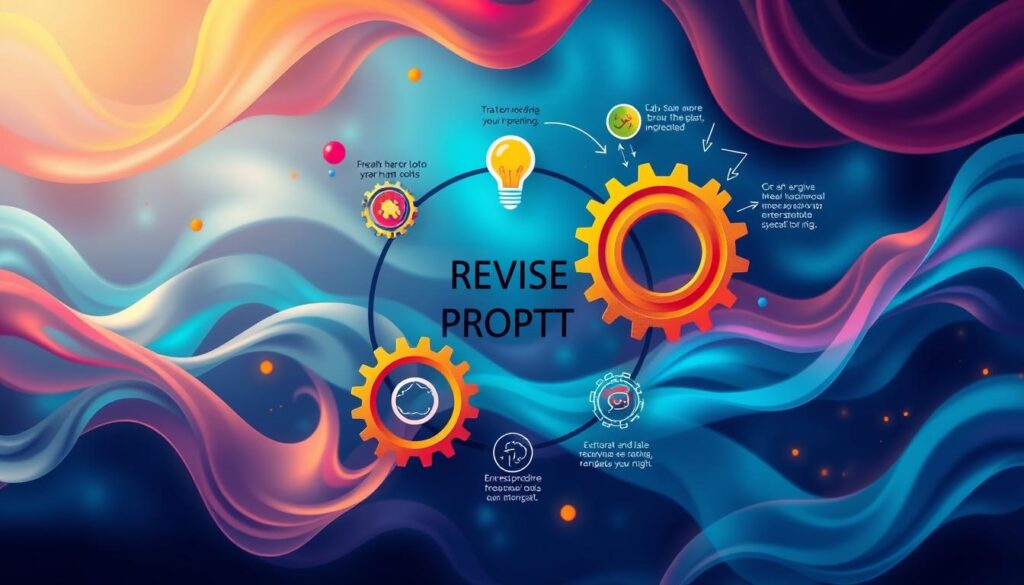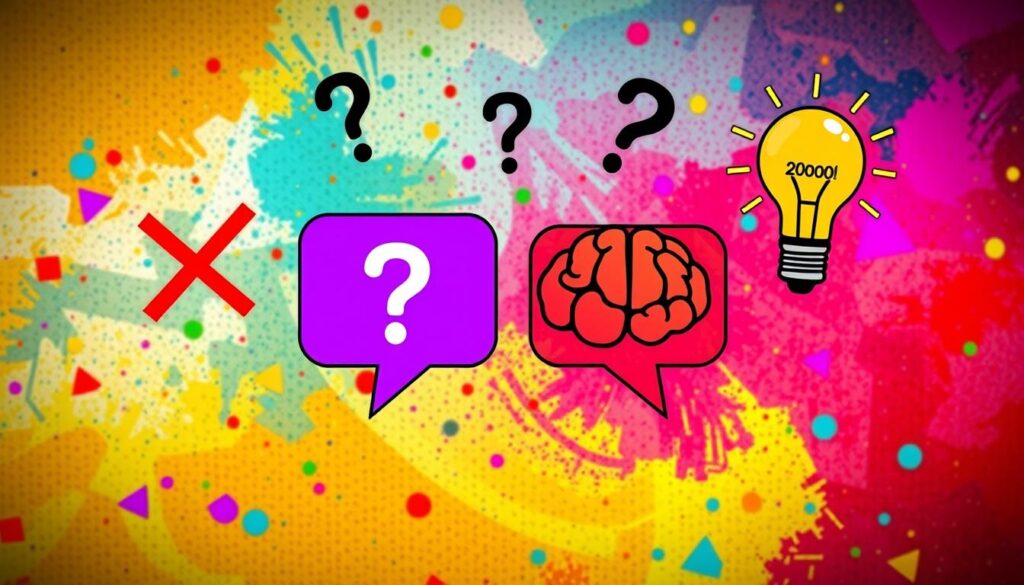“The greatest danger in times of turbulence is not the turbulence—it is to act with yesterday’s logic.” This profound insight from Peter Drucker is especially relevant when using AI tools like ChatGPT. As the need for effective chatbot prompts grows, users must adapt their methods to fully utilize this powerful tool.
To master writing better ChatGPT prompts in 5 steps, understanding the impact of a well-crafted prompt is key. The art of prompt engineering has become a crucial skill, with salaries ranging from $175,000 to $335,000 annually1. By perfecting the creation of precise, context-rich prompts, users can greatly improve their interactions with ChatGPT. This tool has seen significant adoption in various sectors, including coding and marketing2.
This article will outline five critical steps to enhance ChatGPT prompts, leading to more engaging and effective interactions. These steps include setting clear objectives, using straightforward language, experimenting with different structures, adding relevant context, and refining prompts through continuous testing. By adopting these strategies, users can craft chatbot prompts that not only fulfill their requirements but also leverage AI’s evolving capabilities.
Key Takeaways
- Understanding the importance of effective prompts is crucial for quality AI interactions.
- Multi-step questioning can lead to powerful outputs from ChatGPT.
- Providing context improves the relevance of AI-generated answers.
- Minor modifications in prompts can greatly influence results.
- Clear and specific prompts lead to more useful interactions with ChatGPT.
- Developing a variety of prompts aids in grasping the chatbot’s capabilities and limitations.
Understanding the Importance of Effective Prompts
To fully harness the capabilities of AI tools like ChatGPT, it’s crucial to understand the role of effective prompts. These prompts act as specific instructions or questions that guide the AI in generating relevant responses. The clarity and specificity of these prompts directly impact the quality of the chatbot’s output. This highlights the need for thoughtful construction of each input.
What Are ChatGPT Prompts?
ChatGPT prompts are text requests designed to instruct the AI, providing context that is vital for generating specific assets. They should include necessary details, such as the desired tone and format, while guiding the interaction with the AI. Examples show that more specific prompts lead to greater accuracy and relevancy in responses34.
Why Prompts Matter in AI Interactions
Effective prompts are the cornerstone of interactions with AI, dramatically shaping the impact of prompts on outputs. As generative AI technologies evolve, mastering the art of prompt engineering becomes increasingly critical. This skill not only enhances AI’s performance but is also emerging as a career niche, with growing demand across various industries. Companies are actively seeking individuals proficient in writing and data science to refine interactions with these tools5.
Step 1: Define Your Objective

Setting a clear objective is crucial when crafting prompts for ChatGPT. To define objective, you must identify the exact purpose of the interaction. This method helps in creating a focused prompt and improves the AI’s response accuracy. For example, if you aim to get specific marketing strategies for a fashion business, include details about the target audience and desired outcomes. This will lead to more precise ideas67.
Identifying the Purpose of Your Prompt
Understanding the purpose of your prompt is essential for effective interaction. By using writing strategies for ChatGPT, you can create prompts that yield insightful outputs. For instance, when crafting a prompt for generating social media engagement questions, specify the brand and the desired audience interaction7.
Tailoring Your Prompt to Specific End Goals
To get the best out of ChatGPT, tailor your prompts to specific end goals. Avoid vague language and provide detailed instructions. As chatbot writing tips suggest, a well-crafted prompt with context and constraints can greatly enhance AI response quality. Customizing your prompt aligns it with your objective and encourages the AI to work within the given constraints8.
Step 2: Use Clear and Specific Language
Effective prompts demand clear language and precision to ensure the AI generates relevant responses. Ambiguity can lead to misunderstandings, causing ChatGPT to provide less accurate or completely irrelevant answers. Therefore, writers should focus on crafting prompts that avoid ambiguity and clearly convey their intentions. This principle aligns with the understanding that providing specific details within prompts directly influences the quality of outputs received from the AI. When users articulate their requests clearly, ChatGPT can better interpret and respond, leading to improved clarity in communication with the AI.
Avoiding Ambiguity in Your Prompts
To avoid ambiguity, a prompt should be direct and specific. For instance, instead of asking a vague question such as “Give me information,” specifying what type of information is needed will result in a more focused reply. Crafting targeted prompts is essential because it has been shown that detailed prompts yield more accurate outputs; thus, feeding ChatGPT with explicit and direct instructions leads to better results and accuracy9. Moreover, determining the format and length of the desired response is vital for managing expectations effectively.
The Role of Context in Clarity
Providing context in prompts enhances the AI’s ability to generate personalized and relevant answers. Instead of solely asking questions devoid of background information, adding relevant details can shape the dialogue more appropriately10. Context helps ChatGPT leverage its capabilities, allowing it to produce outputs that resonate with the user’s needs. Writers should consider including appropriate background details that could influence the outcome positively10. Understanding the user’s background and experience can significantly impact clarity in communication, thereby enhancing the interaction with the AI.
Step 3: Experiment with Different Structures

To effectively engage with AI, it’s essential to explore various prompt formats. Structure experimentation helps users find the best approach to elicit valuable responses. Different formats, like open-ended questions, commands, or detailed instructions, allow for this exploration. The choice of format greatly influences the quality of interactions and responses.
Various Prompt Formats
Research shows that combining different formats can lead to richer results. For example, using chain-of-thought prompts can improve ChatGPT’s performance in math and logic tasks11. The rephrase and respond strategy also enhances accuracy, sometimes outperforming traditional methods11. Additionally, SimToM prompting, inspired by Simulation Theory, aids in storytelling and understanding emotional contexts11.
Balancing Questions and Statements
Effective questioning is key to dynamic interactions. Therefore, achieving a balance in prompts is vital. Successful prompts mix direct questions with statements, prompting the AI to provide nuanced responses. The framing of a question sets the context, aligning it with the desired outcome. A study found that prompts with requests and references engage ChatGPT more effectively12. This balance enriches user exchanges, leading to more meaningful dialogues.
Step 4: Incorporate Examples and Context
Incorporating examples and relevant background is crucial for crafting effective prompts for ChatGPT. Lucas Pimentel, an AI developer, stresses the importance of clear, descriptive, and accurate tasks. This helps the AI grasp user intentions. With strong context enhancement, ChatGPT can deliver more relevant outputs. This is especially true when specific guidelines or illustrative examples are provided13.
Providing Relevant Background Information
Offering a detailed background aids ChatGPT in understanding the request’s essence. Pimentel suggests breaking down complex tasks into simpler segments. This structured approach leads to clearer directives, aiding the AI in following user requirements accurately13.
Using Examples to Enhance Understanding
Examples in prompts act as benchmarks for ChatGPT, aligning its responses with user expectations. Social media posts underscore the value of detailed guides on prompt creation, including examples14. For example, illustrative scenarios prompt the AI to emulate desired formats and styles. This optimizes its performance according to user specifications. Pimentel’s advice is that refining prompts iteratively can significantly improve outcomes over time13.
Step 5: Revise and Refine Your Prompts

Creating effective ChatGPT prompts requires a deep understanding of the importance of iteration. Through this process, users can refine their prompts, ensuring higher quality content. As they test and evaluate, they learn what adjustments are needed for better results.
Importance of Iteration
Regularly refining prompts is key to improving ChatGPT’s performance. By making adjustments based on previous interactions, users pinpoint areas for improvement. This iterative process enhances prompts, leading to more relevant and clear AI responses. For example, specifying tone and complexity can significantly impact output quality15.
This feedback loop is essential in prompt engineering. It offers insights into how designs can evolve over time.
Testing and Evaluating Prompt Effectiveness
Testing various prompt versions is crucial for optimizing interactions with ChatGPT. Users should systematically assess which prompts yield the best results. Effective prompts consider past outcomes and guide the AI towards more detailed answers. Defining aspects like response length and personalization can enrich the conversation.
Regularly analyzing prompt performance helps users continually refine their prompts16.
By adopting a systematic approach to prompt iteration, users can greatly enhance their interactions with ChatGPT. With each round of testing and evaluation, prompt writing effectiveness improves. This leads to more satisfying interactions with the AI system17.
Additional Tips for Crafting Better Prompts

To excel in crafting effective prompts, users should learn from successful prompting examples. They should apply those insights to their own strategies. By examining high-performing prompts in diverse contexts, individuals can identify effective learning strategies. These strategies enhance their ability to engage with ChatGPT more efficiently.
Learning from Successful Prompts
There are a wealth of successful prompting examples available. These can guide users in their approach. For instance, the use of 234 specific ChatGPT prompts tailored for various industries can inspire users. It encourages them to explore effective content creation techniques in their niche18.
These prompts include 18 designed specifically for SEO content. They provide insights on how to craft relevant and engaging outputs that meet business needs18. Understanding the intricacies of these examples empowers users. It allows them to adopt best practices, such as generating targeted SEO copy or creating engaging blog posts.
Engaging with Feedback for Improvement
Incorporating feedback mechanisms is crucial for improving prompts over time. Receiving constructive feedback on the outputs generated from prompts allows users to refine their approaches. ChatGPT facilitates this process by enabling users to ask for feedback on their writing, enhancing aspects like clarity and tone19.
This creates a loop of continuous improvement. Users can adjust their prompting techniques based on the AI’s responses and suggestions.
Common Mistakes to Avoid

When using ChatGPT, it’s crucial to steer clear of common pitfalls to improve interaction quality. Many users face challenges with simple language, which can lead to AI confusion. Complex language often hinders understanding AI limitations, making it hard for the AI to provide relevant answers. Recognizing the importance of clarity can greatly enhance the effective use of ChatGPT in various settings.
Overly Complex Language
Using complex vocabulary and convoluted sentences can confuse ChatGPT, leading to unsatisfactory results. It’s essential for users to craft prompts that are clear and direct. This approach ensures the AI understands the user’s intent accurately. Professionals often overlook these issues, unaware of the negative effects on their outcomes20.
Ignoring AI Limitations
It’s vital to understand ChatGPT’s limitations to create effective prompts. The AI performs best with clear, specific instructions. Ignoring its constraints can cause misunderstandings and frustration. Acknowledging its inability to process events after 2021 and its reliance on textual inputs highlights the need for tailored requests21. Providing context not only aids in generating accurate responses but also enhances the interaction experience. Knowing these common mistakes helps users improve their engagement with ChatGPT, leading to more productive conversations22.
The Role of Tone in Prompt Writing

The success of a prompt heavily relies on the right tone. Adjusting the tone is key to aligning the AI’s output with what the audience expects. The tone chosen affects how AI responds, influencing the way information is shared. Different tones can drastically change the outcome; a professional tone might lead to formal, detailed answers, while a casual tone could result in friendlier responses.
Adjusting Tone for Different Audiences
It’s vital to adjust the tone of prompts to engage various audience segments. Using multiple tone descriptors can help AI generate more natural responses than relying on a single word. This strategy is crucial for crafting prompts across different fields, such as SEO, blog writing, product descriptions, and brainstorming. The tone’s impact on AI responses is immense, affecting how relatable and effective communication is with users23.
Impact of Tone on AI Responses
The tone used directly influences the quality of AI responses. Studies show that training AI chatbots with existing content improves their performance, allowing for a more genuine tone. By giving AI specific examples to follow, users can achieve a more precise tone without the exaggerations that come with broad descriptors24. Grasping the complex relationship between tone and AI outputs can significantly improve user engagement and satisfaction across different scenarios.
Utilizing ChatGPT’s Capabilities

Understanding ChatGPT’s unique features is crucial for those aiming to fully utilize AI. Recognizing its strengths empowers users to leverage it effectively in business and content creation.
Understanding ChatGPT’s Strengths
ChatGPT stands out as a robust AI model, aiding in brainstorming and content drafting. Its integration with platforms like Latenode and GPT-4 enables businesses to automate processes efficiently. This significantly improves user interactions25. Crafting effective prompts involves clear context and task refinement through roles25. Engaging in natural conversations enhances response quality, leading to more relevant outputs25.
Leveraging Unique Features of ChatGPT
ChatGPT’s ability to maintain context and adapt responses based on feedback is a key feature. This adaptability is crucial for applications like customer support and content generation25. Techniques like Few-shot prompting can significantly boost accuracy by offering specific examples11. It’s important to write concise, effective prompts that clearly outline expectations26. Additionally, ethical considerations such as avoiding plagiarism and integrating personal insights are vital when using AI tools26.
Resources for Further Learning

To excel in crafting effective prompts for ChatGPT, individuals can seek a variety of valuable learning resources. Numerous platforms offer extensive tutorials for prompting that cover both fundamental and advanced techniques. This ensures users can improve their skills effectively.
Recommended Guides and Tutorials
These guides often provide comprehensive insights, examples, and methodologies to enhance prompt engineering. They are indispensable for anyone looking to refine their prompting abilities. Engaging with these tutorials for prompting can lead to a significant boost in user confidence and proficiency.
Online Communities and Forums
Participating in online communities and engaging forums dedicated to AI discussions proves beneficial. Users can share experiences, receive prompt feedback, and learn collaboratively from peers. This interaction not only fosters a sense of community but also enhances individual skills through shared insights and advice. Joining such platforms provides a network of support and valuable knowledge for improving prompt writing.
Case Studies of Effective Prompting

Exploring effective prompting case studies across different sectors unveils a variety of strategies in prompt crafting. These strategies lead to successful outcomes. Each industry offers valuable industry examples of how customized prompts improve AI interactions.
Examples from Diverse Industries
In healthcare, few-shot prompting has shown to be effective in supporting diagnosis systems. Retail has seen benefits from chain-of-thought prompting, which simplifies complex tasks for AI. This enables smoother interactions27. The education sector employs automatic prompt engineering, allowing AI to create context-specific prompts dynamically. This prompt strategy analysis highlights the need for specificity in prompts, ensuring clarity enhances AI performance.
Analyzing Successful Prompt Strategies
Success stories across these fields underscore the value of strategic prompting. Zero-shot prompting, for instance, challenges AI to respond without examples, expanding its generative capabilities. This model encourages active user engagement, leading to a dialogue that builds upon previous responses for deeper insights. As AI becomes more integrated into our daily lives, refining our approach through feedback is crucial. It ensures accuracy and requires caution against AI biases28
The Future of Prompt Engineering

The field of AI is expanding rapidly, making prompt engineering future more critical. New methods will arise to handle AI’s complexities. Understanding the role of custom prompts tailored to individual needs is key. This personalization boosts user satisfaction and AI model performance.
Evolving Techniques in AI Interaction
Recent advancements have shaped prompt engineering. Assistant Professor Yeqing Kong from Georgia Tech will cover prompt engineering in her Fall 2024 course “Responsible AI for Communication.” This highlights the academic backing for this field29. Sébastien Bauer’s rhetorical approach and Lance Cummings’ structured method show the variety of techniques in this area29. These evolving techniques enable more sophisticated interactions between users and AI.
The Growing Importance of Custom Prompts
The role of custom prompts is becoming more apparent as the tech industry demands more prompt engineers. These experts create queries for generative AI models like ChatGPT, marking a shift towards a more sought-after skill30. Crafting precise prompts boosts creativity and ensures AI outputs are relevant. This focus on tailored interactions increases the need for skilled prompt engineers, emphasizing the importance of effective prompt writing across sectors31
Collaboration with ChatGPT

Engaging with ChatGPT opens up new avenues for creativity through AI, enabling real-time collaborative interactions. This dialogue enhances brainstorming, leading to innovative ideas that surpass solo efforts. It encourages users to clearly express their needs, fostering creativity and effective collaboration.
Enhancing Creativity Through Dialogue
Creativity through AI flourishes with informed dialogue with ChatGPT. Studies show that politeness in prompts leads to better results over time, emphasizing the role of rapport in interactions. Clear instructions and context guide the AI’s responses, resulting in more meaningful content. Frameworks like RACE, TAG, and TRACE aid in structuring these interactions, optimizing workflows and enhancing creativity32.
Building a Rapport with the AI
Establishing rapport with ChatGPT is crucial for productive interactions. Casual engagement helps the AI tailor its responses to individual styles and preferences. Refining prompts and specifying desired changes in tone or detail improves collaboration effectiveness. This process, though time-consuming, yields transformative outputs that align with the user’s vision and audience needs. Advanced prompting techniques, such as the Reflection Pattern, deepen interactions by encouraging clarification and reflection33.
Feedback Mechanisms in AI Prompting

Understanding feedback mechanisms in AI prompting is key to better user interaction with generative AI tools. Engaging with AI responses offers valuable insights. These insights are crucial for effective prompting. A structured approach to analyze this feedback can lead to continuous improvement in prompt crafting.
Gathering Insights from AI Responses
Feedback from AI interactions shows the need for clear communication of intent. By examining prompt clarity and structure, users can learn from responses that show effective engagements. Research shows AI is used in tasks like personalized shopping and writing assistance with tools like Grammarly34.
Using tools like ChatGPT reveals that prompt quality and relevance depend on structure, context, and specificity35. As users adapt their prompting based on these insights, they align better with their objectives. This enhances the effectiveness of their interactions.
Using Feedback for Continuous Improvement
Feedback fosters a feedback loop for continuous improvement in prompt writing. This iterative process allows users to refine their approaches based on previous interactions. Research highlights the importance of clear and detailed prompts for relevant AI responses36.
Regular practice with diverse prompt structures and contexts leads to faster results. This makes the creative process more efficient. Users can develop a deeper relationship with generative AI tools, leading to more innovative and tailored outputs in their projects.
Conclusion: Mastering Prompt Writing
Mastering prompt writing is crucial for better interactions with ChatGPT. Key takeaways include defining clear objectives, using specific language, and adding examples for better understanding. It’s also important to recognize that structured prompts can lead to more accurate responses from ChatGPT. Providing context and asking for specific formats can significantly improve the quality of the replies3738.
Improving in prompt writing requires ongoing practice and learning. By using resources, trying different structures, and refining prompts based on feedback, users gain deeper insights. This continuous effort ensures that interactions with ChatGPT are productive and meaningful3738.
Committing to mastering prompt writing not only leads to better results but also deepens understanding of AI interactions. By consistently applying these strategies, users can enjoy more successful and fruitful interactions with AI in their fields3738.
FAQ
What are ChatGPT prompts?
Why are effective prompts important in AI interactions?
How can I define my objective when writing a prompt?
What strategies can I use to avoid ambiguity in my prompts?
How should I structure my prompts for better responses?
What role do examples play in crafting prompts?
How can I improve my prompts through iteration?
What common mistakes should I avoid when writing prompts?
How can tone impact the effectiveness of my prompts?
What resources are available for learning how to craft better prompts?
Source Links
- How to write better ChatGPT prompts in 5 steps – Trinity Worldwide Technologies
- 14 ways to get better at using ChatGPT: Comprehensive prompt guide
- 5 Steps to Write Better ChatGPT Prompts
- 5 Tips for Writing Effective ChatGPT Prompts (+ Examples) (2024) – Shopify Malaysia
- How To Write ChatGPT Prompts: Your 2024 Guide
- How to Write the Perfect ChatGPT Prompt – 6 Essential Steps
- How to Write Effective ChatGPT Prompts [Step by Step Guide + Examples]
- How to Craft the Perfect ChatGPT Prompt
- How to write a prompt, the secrets of ChatGPT revealed
- Writing ChatGPT Prompts That Get Results (with Examples)
- 5 Prompts for Making ChatGPT More Accurate
- Prompt Structure in Conversations with Generative AI
- How To Write Effective Prompts For ChatGPT: 7 Essential Steps For Best Results
- A Guide to Crafting Effective Prompts for Diverse Applications
- Write the perfect ChatGPT prompts in 5 easy steps! – neuroflash
- 5 Tips for Writing Effective ChatGPT Prompts (+ Examples) (2024) – Shopify Indonesia
- 6 ways to write better ChatGPT prompts – and get the results you want faster
- 234 ChatGPT Prompts (& How to Write Your Own)
- 17 Tips to Take Your ChatGPT Prompts to the Next Level
- 5 Common Generative AI Prompt Writing Mistakes (And How To Fix Them)
- How To Write Better ChatGPT Prompts & Become A Prompt Writer
- 5 ChatGPT Prompt Mistakes to Avoid in 2024 – Academic Hive
- 5 Tips for Writing Effective ChatGPT Prompts (+ Examples) (2024) – Shopify Canada
- ChatGPT and Tone: Avoid Sounding Like a Robot
- How to Write Better ChatGPT Prompts
- Guide to Writing Essays with ChatGPT: 5 Steps
- Prompting Techniques – Write better ChatGPT Prompts
- Effective Prompts for AI: The Essentials – MIT Sloan Teaching & Learning Technologies
- Prompt Engineering: The Art of Getting What You Need From Generative AI
- Prompt engineering tips for ChatGPT and other LLMs | TechTarget
- Mastering Prompt Engineering for ChatGPT
- 11 ChatGPT Prompt Frameworks Every Marketer Should Know
- 5 advanced prompts to get better answers from ChatGPT
- How to Write AI Prompts: 5 Expert Tips
- 7 Tips to Improve Your ChatGPT Prompts for Optimal Results
- How to write prompts for ChatGPT: AI in your classroom
- How to Write Better ChatGPT Prompts in 5 Steps: A Comprehensive Guide
- The Anatomy of a Perfect ChatGPT Prompt: How to Write Prompts that Get the Best Results











